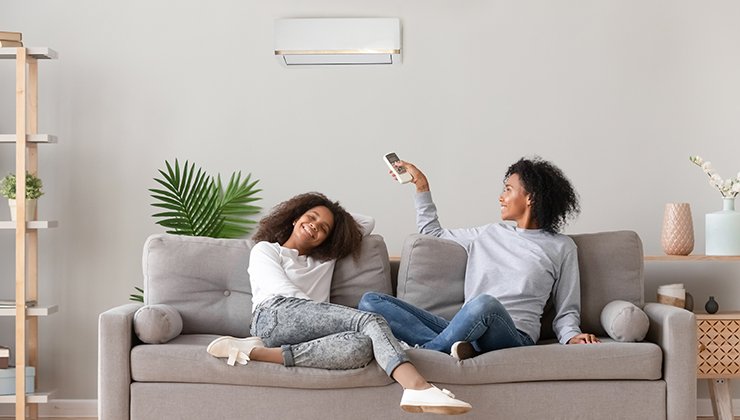Give up my AC? Only for a heat pump.
Put the clunky window A/C unit to the curb, and upgrade to a heat pump.
Efficient and full of cooling power, electric heat pumps can lower your home’s temps while they lower your costs
You’re on the ladder, balancing yourself as you wedge the AC unit into the window in a yearly ritual, even though you know it’s going to bust your budget all summer. You think there has to be a better way, and there is.
Western New York summer is here. From Geneseo to Geneva, Honeoye to Hilton, we know August in the Finger Lakes region is just heating up when the thermometer hits the 80s and 90s. Add the usual humidity and any of us with an AC unit is probably reaching for the thermostat by midday. But with energy prices rising along with the temperature, it’s time to look at a more efficient and cost-effective way to cool our homes—the electric heat pump.
No, the name doesn’t immediately conjure visions of chilly air, but heat pumps can deliver all the benefits of a typical AC system during the summer. And they do double duty the rest of the year heating your home instead of a furnace, all for less money and with far fewer carbon emissions.
How? By transferring heat between the natural environment and your home, depending on the season.
Heat pumps can heat or cool your home, using the same technology as your fridge (source: LGHVACstory.com).
Air-source heat pumps
Air-source heat pumps are the most common, and pull warm air out from inside your home to cool it down. They have the added benefit of controlling humidity better than conventional AC, for lower energy usage and a space that’s more comfortable as well as cooler. The heat pumping process is reversed in winter, pulling warmer air inside to keep you cozy while the lake effect piles up outside.
Ground-source heat pumps
Ground-source (or geothermal) heat pumps extract the heat of the ground or underground water through sunk pipes, transferring warmer or cooler air to your home as needed. These units are the most efficient kind of heat pump, but can have a larger cost and space investment.
Air source heat pumps like a ductless mini-split keep you cool in the summer and warm in the winter (NYS Clean Heat Program).
Stay cool (and warm) for less
Whether you’re currently using oil, propane, or electric resistance to heat your home, and cooling it down with window units or a full AC system, a heat pump is typically going to lower your spend. A recent article in Bloomberg broke the numbers down this way: The price of a conventional air conditioning system ranges from $3,800 to $7,500, and a gas furnace $2,000 to $6,000. Equipment and installation costs for an air-source heat pump typically run from $4,000 to $12,000, so you could replace both for roughly the same cost.
But more savings come from efficiency and lifespan. The same Bloomberg article noted a report from the nonprofit RMI showing that an average household could save over $200 a year with a high-efficiency electric heat pump. Long-term, they have lower maintenance than conventional AC systems and furnaces, can provide relief from the fluctuating costs of fossil fuels, and just plain last longer.
And let’s be honest. No more struggling to get AC units into your windows every summer sounds pretty sweet too.
Your air-source heat pump could save $228/year and generate 25% less CO2 (RMI).
Cooler air, cleaner air
There are better ways to stay cool.
While your house gets more comfortable for the summer with a heat pump, it’s also getting more climate-friendly. Not only do air-source heat pumps not use fossil fuels, lowering the carbon footprint of your home (up to 25%, according to that BMI study), they don’t need to store any fuel like your conventional furnace does. That means cleaner, safer air in your home and less risk of a carbon monoxide release.
While heat pumps do use electricity, they are extremely efficient, using less energy than they extract because they concentrate and move heat instead of having to generate it. The US Department of Energy notes that modern heat pumps can reduce electricity use for heating by approximately 50% compared to furnaces and baseboard heaters.
Right time, right place
Summer here is already hot enough, but climate change means more extreme heat events on the horizon, even for temperate areas like Western New York. Heat pumps can help us meet the moment, lowering our homes’ temperatures, our energy costs, and our carbon emissions all at the same time.
New York State is making it easier, with rebates on heat pump purchases through the Clean Heat program run by NYSERDA. For instance, Rochester customers of RG&E have saved an average of $3,000 on their new equipment when installing a whole home air-source heat pump system.




